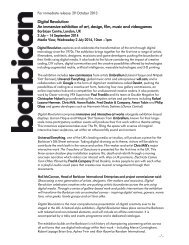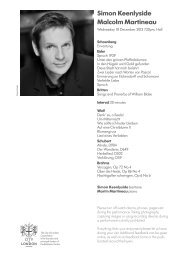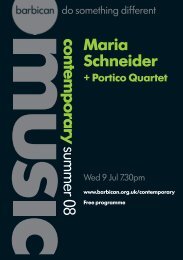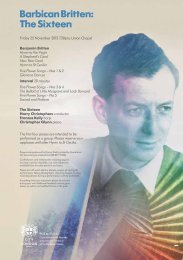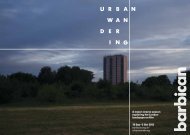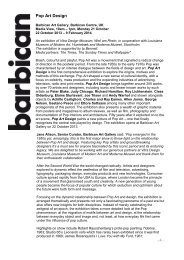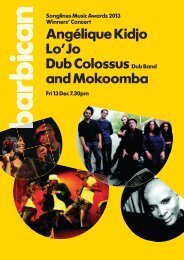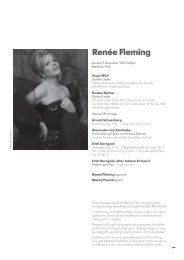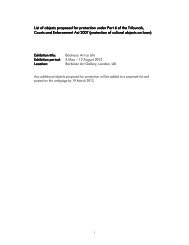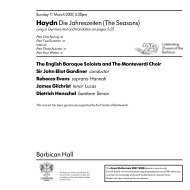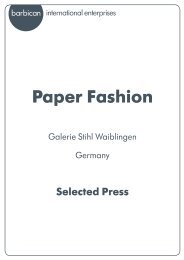Download your concert programme here - Barbican
Download your concert programme here - Barbican
Download your concert programme here - Barbican
You also want an ePaper? Increase the reach of your titles
YUMPU automatically turns print PDFs into web optimized ePapers that Google loves.
Thursday 4 February<br />
John Adams (born 1947)<br />
The Wound-Dresser (1988)<br />
Thomas Hampson baritone<br />
John Adams may have started out as a minimalist, but it has<br />
been a long time since he graduated from that description<br />
to become one of America’s most widely performed<br />
composers of <strong>concert</strong> music, a distinction he achieved thanks<br />
to a style in which musical richness and stylistic variety are<br />
deeply connected to the mainstream impetuses of classical<br />
music. He grew up studying clarinet and became so<br />
accomplished that he occasionally performed with the<br />
Boston Symphony Orchestra. At Harvard he studied<br />
composition with a starry list of teachers that included Leon<br />
Kirchner, Earl Kim, Roger Sessions, Harold Shapero, and<br />
David Del Tredici. After that, armed with a copy of John<br />
Cage’s book Silence (a graduation gift from his parents), he<br />
left the ‘eastern establishment’ for the relative aesthetic<br />
liberation of the West Coast. He arrived in California in 1971<br />
and has been based in the Bay Area ever since. During his<br />
first decade t<strong>here</strong> Adams explored an evolving fascination<br />
with the repetitive momentum of minimalism, but by 1981 he<br />
was describing himself as ‘a minimalist who is bored with<br />
minimalism’.<br />
Among Adams’s most internationally acclaimed works are<br />
his operas, which characteristically address the personal<br />
stories behind momentous political or historical events: Nixon<br />
in China (1987, which considers Richard Nixon’s historic 1972<br />
meeting with Mao Tse-tung), The Death of Klinghoffer (1990,<br />
inspired by the hijacking, five years earlier, of the cruise ship<br />
Achille Lauro), I Was Looking at the Ceiling and Then I Saw<br />
the Sky (1995, a ‘song play’ set in the aftermath of the 1994<br />
Los Angeles earthquake), and Doctor Atomic (premiered in<br />
2005, involving the testing of the first atomic bomb, and<br />
which Alan Gilbert led to great acclaim at the Metropolitan<br />
Opera in 2008). Adams’s most recent opera, A Flowering<br />
Tree (2006), returns to more classic operatic territory, setting<br />
a South Indian folktale that involves personal transformations<br />
and moral choices. In some of these scores, as in many of his<br />
instrumental compositions, one finds the confluence of<br />
popular and classical styles, the mixing of high and low<br />
aesthetics, which reflects the breadth of his inspiration and his<br />
comprehensive language.<br />
In 2003 Adams succeeded Pierre Boulez as composer-inresidence<br />
at Carnegie Hall, remaining in the post until 2007,<br />
and in 2009 he became creative chair of the Los Angeles<br />
Philharmonic. In addition to his activities as a composer, he<br />
has grown increasingly active as a conductor, and has led<br />
9




